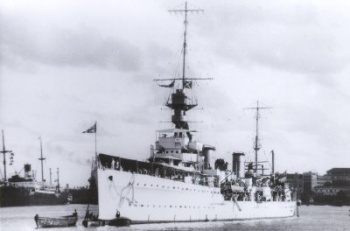Post by Diarist on Jul 6, 2014 13:00:00 GMT 1
Danae Class
The Danaes were based on the design of the preceding C class series, but were lengthened by 20 feet (6 m) to allow a sixth 6-inch (152 mm) gun to be worked in between the bridge and the forefunnel. This gave an 'A', 'B', 'P', 'Q', 'X', 'Y' arrangement. Additionally, the twin torpedo tubes in the C class were replaced by triples, giving the Danaes a total of twelve tubes, the heaviest torpedo armament for a cruiser at the time. Machinery and general layout is otherwise the same as the Ceres group of C class cruisers. However, Danae, Dauntless and Dragon were ordered before the Capetown group, and therefore did not incorporate the improved bow design of the latter; the C class were very wet forwards, and in the Capetowns sheer was increased forwards into a knuckled "trawler bow". Such was the success of the knuckled bow that it was incorporated into all subsequent British cruisers. Despatch and Diomede had their beam increased by ½ foot to increase stability and Dragon and Dauntless were completed with a hangar for a floatplane built into the bridge, the compass platform being on top. Delhi, Dunedin, Durban, Despatch and Diomede were provided with flying-off platforms for a wheeled aircraft aft. Despatch and Diomede were completed with 4 inch anti-aircraft (A/A) guns vis 12 pounder (3 inch) guns in their sisters and Diomede had 'A' gun shipped in a weatherproof housing CP Mark XVI, an encouraging development for gun crews hitherto exposed to the worst of the elements on the fo'c'sle.
Ships
Three ships were ordered in September 1916 under the War Emergency Programme:
Danae — built by Sir W. G. Armstrong Whitworth and Company, High Walker,laid down 11 December 1916, launched 26 January 1918, completed 18 July 1918.
Dauntless — built by Palmers Shipbuilding and Iron Company, Jarrow,laid down 3 January 1917, launched 10 April 1918, completed 2 December 1918.
Dragon — built by Scotts Shipbuilding and Engineering Company, Greenock, laid down 24 January 1917, launched 29 December 1917, completed 16 August 1918.
Three more ships were ordered in July 1917 under the War Emergency Programme:
Delhi — built by Armstrong Whitworth,laid down 29 October 1917, launched 23 August 1918, completed 7 June 1919.
Dunedin — built by Armstrong Whitworth,laid down 5 November 1917, launched 19 November 1918, completed by Devonport Royal Dockyard October 1919.Transferred to Royal New Zealand Navy 1925.
Durban — built by Scotts,laid down 22 June 1918, launched 29 May 1919, completed by Devonport Royal Dockyard 1 September 1921.
Finally, six more ships were ordered in March 1918 under the War Emergency Programme but only two were built:
Despatch — built by Fairfield Shipbuilding and Engineering Company, Govan,laid down 8 July 1918, launched 24 September 1919, completed Chatham Royal Dockyard 2 June 1922.
Diomede — built by Vickers Limited, Barrow-in-Furness,laid down 3 June 1918, launched 29 April 1919, completed Portsmouth Royal Dockyard 24 February 1922. Transferred to Royal New Zealand Navy 1925.
Emerald Class
The Emerald class or E class is a class of two light cruisers built for the Royal Navy. Following the Cavendish class, three ships of a new class were ordered in March 1918, towards the end of the Great War, designed to emphasise high speed at the cost of other qualities, for use against rumoured new high speed German cruisers - like the Brummer class - and particularly minelayers, in the North Sea. However, the third ship was cancelled in November 1918.
Design
The E class were based on the preceding Danae class, but had a very high ratio of length to beam, and only one more gun despite being much bigger and more expensive. Much was sacrificed to achieve 33 knots (61 km/h), the horsepower was doubled and the hull increased by 100 ft (30 m) in length, and a 50% increase in displacement. Only two ships were actually built, and completed in 1926. Four propellers were necessary for the increased power, and were driven from two engine rooms. There were four boiler rooms, nos. 2 and 3 being arranged side-by-side with the exhausts trunked into a common funnel. The magazines were between boiler rooms nos. 2 and 3 and the forward engine room, and between boiler room no. 4 and the after engine room. This led to a bizarre funnel arrangement, accentuated further when in 1935 a longer catapult required the mainmast to be stepped forward of the after funnel, and the funnels were heightened by 5 ft (1.5 m).
In the early 1930s Enterprise was fitted with a prototype twin 6" turret in place of her two forward single mounts; and with trials of the turret proving successful it was retained on Enterprise for the rest of her career. The turret design was later installed in the Leander, Amphion and Arethusa classes. The turret installation occupied less space than the superimposed 'A' and 'B' guns of Emerald, therefore the bridge was placed further forward. The bridge was of a new design, being a single block topped by a director tower, rather than the traditional platforms built around the foremast and wheelhouse topped with a spotting top. This design of bridge would appear in the County-class cruisers.
Ships
Emerald, built by Sir W. G. Armstrong, Whitworth and Company, Elswick, laid down 23 September 1918, launched 19 May 1920, and completed at Chatham Royal Dockyard in January 1926.
Enterprise, built by John Brown and Company, Clydebank, laid down 28 June 1918, launched 23 December 1919, and completed at Devonport Royal Dockyard in April 1926.
Source: Wikipedia - en.wikipedia.org/wiki/Danae-class_cruiser and en.wikipedia.org/wiki/Emerald-class_cruiser


